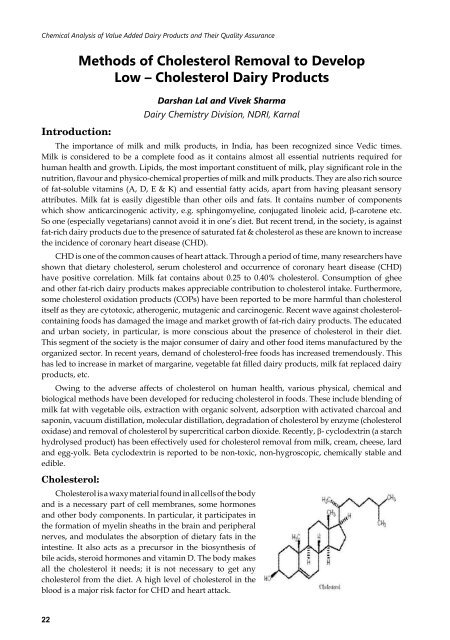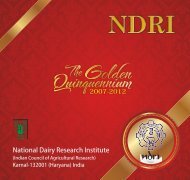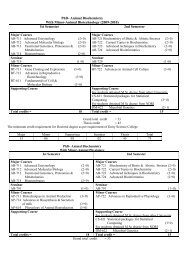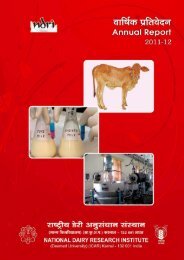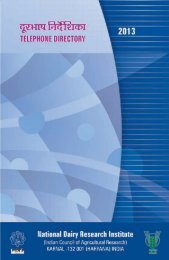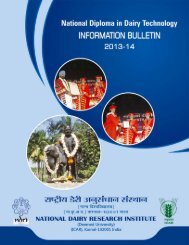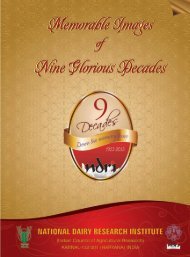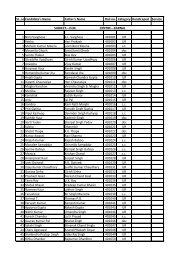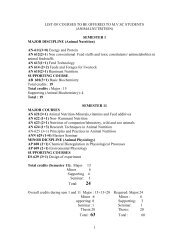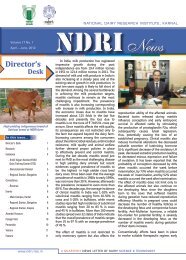Chemical Analysis of Value Added Dairy Products and Their Quality ...
Chemical Analysis of Value Added Dairy Products and Their Quality ...
Chemical Analysis of Value Added Dairy Products and Their Quality ...
Create successful ePaper yourself
Turn your PDF publications into a flip-book with our unique Google optimized e-Paper software.
<strong>Chemical</strong> <strong>Analysis</strong> <strong>of</strong> <strong>Value</strong> <strong>Added</strong> <strong>Dairy</strong> <strong>Products</strong> <strong>and</strong> <strong>Their</strong> <strong>Quality</strong> AssuranceIntroduction:Methods <strong>of</strong> Cholesterol Removal to DevelopLow – Cholesterol <strong>Dairy</strong> <strong>Products</strong>Darshan Lal <strong>and</strong> Vivek Sharma<strong>Dairy</strong> Chemistry Division, NDRI, KarnalThe importance <strong>of</strong> milk <strong>and</strong> milk products, in India, has been recognized since Vedic times.Milk is considered to be a complete food as it contains almost all essential nutrients required forhuman health <strong>and</strong> growth. Lipids, the most important constituent <strong>of</strong> milk, play significant role in thenutrition, flavour <strong>and</strong> physico-chemical properties <strong>of</strong> milk <strong>and</strong> milk products. They are also rich source<strong>of</strong> fat-soluble vitamins (A, D, E & K) <strong>and</strong> essential fatty acids, apart from having pleasant sensoryattributes. Milk fat is easily digestible than other oils <strong>and</strong> fats. It contains number <strong>of</strong> componentswhich show anticarcinogenic activity, e.g. sphingomyeline, conjugated linoleic acid, β-carotene etc.So one (especially vegetarians) cannot avoid it in one’s diet. But recent trend, in the society, is againstfat-rich dairy products due to the presence <strong>of</strong> saturated fat & cholesterol as these are known to increasethe incidence <strong>of</strong> coronary heart disease (CHD).CHD is one <strong>of</strong> the common causes <strong>of</strong> heart attack. Through a period <strong>of</strong> time, many researchers haveshown that dietary cholesterol, serum cholesterol <strong>and</strong> occurrence <strong>of</strong> coronary heart disease (CHD)have positive correlation. Milk fat contains about 0.25 to 0.40% cholesterol. Consumption <strong>of</strong> ghee<strong>and</strong> other fat-rich dairy products makes appreciable contribution to cholesterol intake. Furthermore,some cholesterol oxidation products (COPs) have been reported to be more harmful than cholesterolitself as they are cytotoxic, atherogenic, mutagenic <strong>and</strong> carcinogenic. Recent wave against cholesterolcontainingfoods has damaged the image <strong>and</strong> market growth <strong>of</strong> fat-rich dairy products. The educated<strong>and</strong> urban society, in particular, is more conscious about the presence <strong>of</strong> cholesterol in their diet.This segment <strong>of</strong> the society is the major consumer <strong>of</strong> dairy <strong>and</strong> other food items manufactured by theorganized sector. In recent years, dem<strong>and</strong> <strong>of</strong> cholesterol-free foods has increased tremendously. Thishas led to increase in market <strong>of</strong> margarine, vegetable fat filled dairy products, milk fat replaced dairyproducts, etc.Owing to the adverse affects <strong>of</strong> cholesterol on human health, various physical, chemical <strong>and</strong>biological methods have been developed for reducing cholesterol in foods. These include blending <strong>of</strong>milk fat with vegetable oils, extraction with organic solvent, adsorption with activated charcoal <strong>and</strong>saponin, vacuum distillation, molecular distillation, degradation <strong>of</strong> cholesterol by enzyme (cholesteroloxidase) <strong>and</strong> removal <strong>of</strong> cholesterol by supercritical carbon dioxide. Recently, β- cyclodextrin (a starchhydrolysed product) has been effectively used for cholesterol removal from milk, cream, cheese, lard<strong>and</strong> egg-yolk. Beta cyclodextrin is reported to be non-toxic, non-hygroscopic, chemically stable <strong>and</strong>edible.Cholesterol:Cholesterol is a waxy material found in all cells <strong>of</strong> the body<strong>and</strong> is a necessary part <strong>of</strong> cell membranes, some hormones<strong>and</strong> other body components. In particular, it participates inthe formation <strong>of</strong> myelin sheaths in the brain <strong>and</strong> peripheralnerves, <strong>and</strong> modulates the absorption <strong>of</strong> dietary fats in theintestine. It also acts as a precursor in the biosynthesis <strong>of</strong>bile acids, steroid hormones <strong>and</strong> vitamin D. The body makesall the cholesterol it needs; it is not necessary to get anycholesterol from the diet. A high level <strong>of</strong> cholesterol in theblood is a major risk factor for CHD <strong>and</strong> heart attack.22


